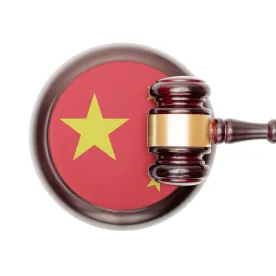On November 17, 2022 the Supreme People’s Court (SPC) of China held a press conference announcing the release of Typical Anti-Unfair Competition Cases of People’s Courts (人民法院反不正当竞争典型案例). Per the SPC, one of the main goal of the release is “strengthen the judicial protection of trade secrets and unify the standards of legal application” as two of the cases involved trade secret misappropriation – one in the pharma space and one in the semiconductor space.

The summaries from the SPC of the two trade secret cases follows:
9. Dispute over infringement of trade secrets by “guanidinoacetic acid”
– Determination of the licensee’s confidentiality obligations
[case number]
最高人民法院(2020)最高法知民终621号
[Beijing Junde Tongchuang Biotechnology Co., Ltd. v. Shijiazhuang Zexing Amino Acid Co., Ltd., Hebei Daxiao Biotechnology Co., Ltd. Infringement of Technical Secrets Dispute]
【Basic case】
The main business of Junde Tongchuang Company is the research and development, production and sales of feed additives. It owns the invention patent right of the guanidine hydrochloride-chloroacetic acid method, and protects the glycine-cyanamide method as a trade secret. In June 2010, Junde Tongchuang Company and Zexing Company signed a strategic cooperation agreement and an entrusted processing agreement for the development of guanidinoacetic acid project respectively, agreeing that Zexing Company would process feed-grade guanidinoacetic acid products for Junde Tongchuang Company and provide production equipment, a site and other support. The agreement also clarified that Zexing Company should strictly control the leakage of guanidinoacetic acid production technology and not sell it to a third party, otherwise it should compensate Junde Tongchuang Company for its economic losses. The contract and confidentiality period are three years. In June 2012, Junde Tongchuang Company provided the production process to Zexing Company. After that, the two parties terminated their cooperative relationship in June 2014. Beginning in the second half of 2016, Junde Tongchuang Company discovered that when Daxiao Company promoted and sold its feed-grade guanidinoacetic acid products, it claimed that the production process came from Junde Tongchuang Company, Zexing Company or was related to the two companies. At the same time, the product analysis report issued by Daxiao Company shows that the quality of the guanidine creatine acetic acid (feed grade) product sold by the company is in line with the strategic cooperation agreement. Daxiao Company is an affiliated enterprise of Zexing Company. Junde Tongchuang Company then filed this lawsuit, claiming that Zexing Company and Daxiao Company jointly infringed the trade secrets of Junde Tongchuang’s guanidinoacetic acid products, and requested that the two companies be ordered to stop the infringement and jointly compensate for economic losses and reasonable expenses. The court of first instance held that the actions of Zexing Company and Daxiao Company constituted the use and disclosure of Junde Tongchuang Company’s trade secrets involved in the case, and ruled that Zexing Company and Daxiao Company should stop the infringement and jointly compensate Junde Tongchuang Company for economic losses. Zexing Company and Daxiao Company appealed. The Supreme People’s Court held in the second instance that, based on the specific evidence and facts of this case, it can be determined that after the expiration of the confidentiality period stipulated in the strategic cooperation agreement and the entrusted processing agreement, although Zexing Company’s agreed confidentiality obligation is terminated, it still needs to bear the liability. After the expiration of the confidentiality period stipulated in the strategic cooperation agreement and the processing agreement, although the agreed confidentiality obligation of Zexing Company was terminated, Zexing Company shall still be obligated to passively refrain from infringing upon the lawful rights and interests of others in the sense of the tort law, and be obligated to maintain confidentiality after the expiration of the agreed confidentiality period under the contract based on the principle of good faith. After the confidentiality period stipulated in the technical license contract expires, Zexing Company may only use the relevant trade secret by itself, and may not license others to use or disclose the relevant trade secret. In the final judgment of the Supreme People’s Court, the relevant judgment of the first instance was revoked, Zexing Company was ordered to cease allowing others to use the trade secret involved in the case, Daxiao Company was ordered to cease using the trade secret involved in the case, and Junde Tongchuang Company was ordered to be compensated for its economic losses jointly.
【Typical meaning】
This case is a typical case of stopping the infringement of trade secrets. The second-instance judgment made it clear that after the expiration of the confidentiality period stipulated in the trade secret licensing contract, the licensee’s agreed confidentiality obligation terminates, but it still needs to bear the obligation of non-action not to infringe the legitimate rights and interests of others and the accompanying confidentiality obligation based on the principle of good faith. This case is of typical significance for advocating the principle of good faith and strengthening the protection of trade secrets.
10. Case on Preservation Measures for Infringement of Technical Secrets by “Chip Mass Production Test System”
——Application of injunctions in cases of infringement of trade secrets
[case number]
最高人民法院(2020)最高法知民终1646号 [Action Technology Co., Ltd. v. Peng, Zhuhai Taixin Semiconductor Co., Ltd.
Infringement of Technical Secrets Dispute]
【Basic case】
Peng used to be an employee of Action and served as a senior system design engineer. The two parties signed the “Employee Confidentiality Agreement”. During his work in Action, Peng participated in the research and development of the “chip mass production test system” and other technical information involved in the case, and then resigned to work in Taixin. Action filed a lawsuit on the grounds that Peng and Taixin had infringed upon its trade secrets. The court of first instance held that the evidence provided by Action was insufficient to prove that Peng and Taixin had disclosed and used the trade secrets involved in the case, so it ruled to reject all Action’s claims. Action Company appealed to the Supreme People’s Court, and filed an application for an injunction (behavior preservation) ordering Peng and Taixin Company not to disclose, use, or allow others to use the trade secrets involved in the case. The Supreme People’s Court at second instance held that based on the existing evidence in this case, it can be determined that the trade secrets involved in the case may indeed be held, disclosed, and used illegally. Therefore, the court of first instance should re-examine whether Peng and Taixin have infringed on trade secrets . While remanding the case for retrial, the Supreme People’s Court ruled that Peng and Taixin shall not disclose, use, or allow others to use the technical information involved in the case before the effective judgment is made. Peng and Taixin Company applied for reconsideration. The Supreme People’s Court rejected its reconsideration request after review.
【Typical meaning】
This case is the first typical case in which the people’s court ruled to adopt an injunction (behavior preservation) while remanding the case for retrial, reflecting the people’s court’s active exploration of strengthening judicial protection of intellectual property rights. Temporary injunctions were adopted when the case was remanded for retrial, which effectively reduced the risk of the trade secrets involved in the case being illegally disclosed and used again, and provided strong protection for the owner of trade secrets. The people’s courts can timely issue injunctions in light of the circumstances of the case, which is of exemplary significance for improving the timeliness and effectiveness of trade secret protection.
The full list with explanations can be found here (Chinese only).



 />i
/>i

